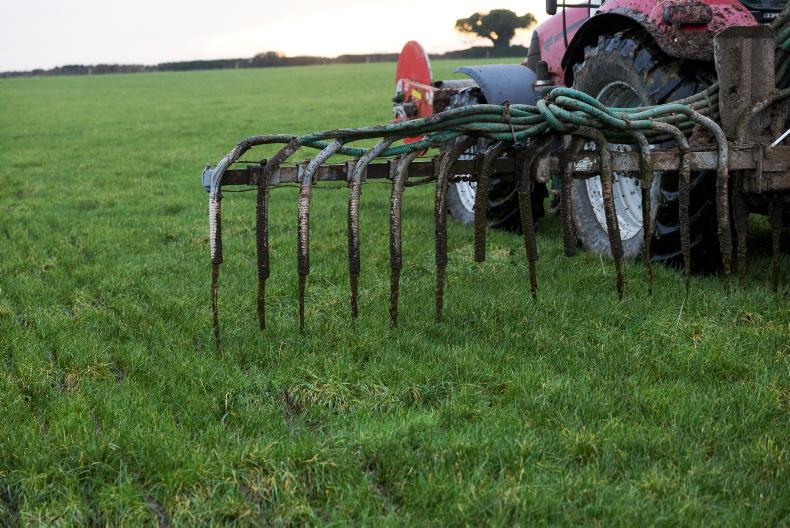Why is there a closed period for spreading manure?
The closed period is something that regularly causes frustration and is often questioned.
Such scenarios occur when you have four or five weeks of continuous dry weather in December and early January, in the run-up to the end of the closed period.
Slurry tanks are getting full and then, typically, just before the start of the “open” period for spreading, it starts to rain and doesn’t know when to stop. Frustration and annoyance at such times are very understandable.
However, there is good reason for this piece of regulation.
For over 16 years now Teagasc’s Agricultural Catchments Programme has been continuously measuring nitrogen (N) in streams leaving six agricultural “catchment” areas.
N concentrations are taken every 10 minutes and river flow (volume) is constantly measured. This allows the total amount of N leaving the catchment to be calculated for any period of time. Every day, week, month, year, for the closed period or in a flood after a very wet time for example.
The closed period for spreading slurry now runs from the beginning of October until mid- or end of January, depending on where in the country your farm is located. This is just over a quarter of the year.
After 16 years of monitoring, we know that up to half of the total annual amount of N leaves the catchment in the stream during the closed period.
Nitrogen loss from the landscape is seasonal, and if we want to reduce the total amount leaving during the full year it makes sense to target actions at the time when they will have the biggest effect.
Nitrogen
With the earlier example of a dry period in mid-winter, you could well ask why nitrogen loss is so seasonal.
There are a number of reasons, all related to the way nitrogen is lost to streams and rivers. Nitrate (NO3-) is the form of nitrogen that is lost to water, it’s a mineral form of nitrogen that is taken up by growing crops (think of net nitrate fertiliser for example) but it is also very easily dissolved in water.
Dissolved nitrate in soil water that is not taken up by growing plants is carried by water moving down through the soil, eventually reaching groundwater (the water table above).
It then enters rivers and streams via groundwater and land drains. (Overland flow and surface run-off are not the major concern for nitrate loss). So, two things are required for nitrate loss to occur (i) surplus nitrate in the soil, above crop requirement and (ii) water moving down through the soil.
There are many sources of nitrate in the soil, some applied and some occurring naturally. It doesn’t really matter where they come from, but far more important is matching the amount in the soil with crop demand.
Shorter days and lower temperatures during the closed period reduce crop growth rates and the uptake of nitrate.
Naturally occurring nitrate in the soil from the microbial mineralisation of organic matter is sufficient to support these lower growth rates, so the addition of any further nitrogen is likely to result in surplus nitrate, increasing the risk of loss.
Evapotranspiration
While we can and often do have periods of no rainfall during the closed period, soils very rarely if ever have a soil moisture deficit during the winter months because rates of evapotranspiration are low at this time of the year.
Evapotranspiration is when soil moisture is taken up by growing crops and released into the air through plant leaves.
Over the full year, approximately half a metre of water is taken up by evapotranspiration, and the remainder (effective rainfall) ends up supplying rivers.
Due to day length, the rates of evapotranspiration vary throughout the seasons, being little or nothing during the winter months, and reaching 4mm+ a day in June and July (80mm to 100mm a month).
When the amount of evapotranspiration is greater than rainfall, soils dry out and water stops moving down. Consequently, nitrate leaching does not happen during these situations.
There is not much that can be done to change the rate of evapotranspiration, so actions to reduce nitrate leaching need to be focused on minimising the amount of surplus nitrate in the soil before the onset of leeching, following the ‘recharge’ period when soils get wet again after the end of the summer.
Hence the advice is to apply all sources of nitrogen well in advance of the end of the growing season, when there is a better uptake and response by growing crops and less surplus left behind in the soil at a time when leaching is more likely.
Edward Burgess works with the Agricultural Catchments Programme, which is informing many actions in Teagasc’s Better Farming for Water campaign.






 This is a subscriber-only article
This is a subscriber-only article










SHARING OPTIONS: